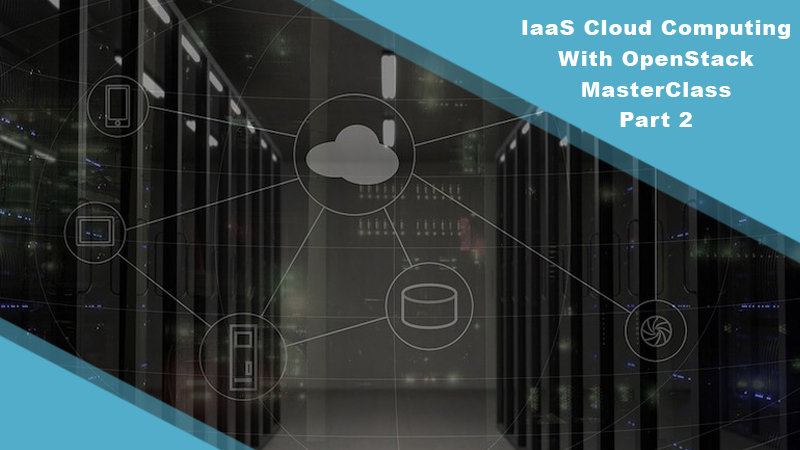IaaS Cloud Computing With OpenStack Masterclass - Part 2
in Cloud ComputingAbout this course
OpenStack, launched in 2010 as a joint project between RackSpace Hosting and NASA, has evolved into one of the most widely adopted open-source platforms for building both private and public clouds. With contributions from over 500 companies, OpenStack provides enterprises with a flexible, scalable, and cost-efficient solution to manage compute, storage, and networking resources across a data center.
This course introduces you to the world of OpenStack, its architecture, and its services. As a cloud operating system, OpenStack enables organizations to deliver business agility and efficiency by offering key capabilities such as on-demand provisioning, resource pooling, high elasticity, and measured services. It also provides powerful self-service lifecycle management features, allowing users to run, resize, reboot, suspend, and terminate instances without manual intervention—making it a strong alternative for organizations seeking greater autonomy compared to public cloud providers like AWS, Azure, or Google Cloud.
Throughout the course, you will begin with an overview of OpenStack and its core services, followed by deep-dives into individual components. Each module will focus on the architecture, installation, and configuration of these components with practical, step-by-step demonstrations. To ensure effective learning, complex concepts will be explained in simple and accessible language. Additionally, quizzes at the end of each module will help reinforce your understanding and track your progress.
By the end of the course, you will be equipped with the knowledge and skills to deploy, configure, and manage an OpenStack-powered private cloud, empowering you to maintain full control over your organization’s data while leveraging the benefits of cloud computing.
Learning Objectives
By completing this course, learners will be able to:
• Explain the fundamentals of OpenStack and its role as a cloud operating system.
• Identify and describe key OpenStack services and their functions.
• Understand the architecture of core components such as Compute, Storage, and Networking.
• Install and configure OpenStack services in a real-world environment.
• Perform lifecycle management operations (launch, resize, reboot, suspend, terminate instances).
• Apply best practices for managing and troubleshooting OpenStack deployments.
Target Audience
• IT administrators and system engineers who want to design and manage private cloud infrastructures.
• Cloud architects and DevOps professionals seeking hands-on expertise in OpenStack.
• Developers looking to deploy applications within OpenStack-based environments.
• Students, researchers, and professionals aspiring to build a career in cloud computing and open-source technologies.
Prerequisites
Learners should have:
• A basic understanding of virtualization concepts.
• Knowledge of programming/scripting languages such as Python, YAML, or Bash.
• Familiarity with Microsoft Visual Studio Code.
• Basic networking knowledge with a solid grasp of the OSI model.
This course introduces you to the world of OpenStack, its architecture, and its services. As a cloud operating system, OpenStack enables organizations to deliver business agility and efficiency by offering key capabilities such as on-demand provisioning, resource pooling, high elasticity, and measured services. It also provides powerful self-service lifecycle management features, allowing users to run, resize, reboot, suspend, and terminate instances without manual intervention—making it a strong alternative for organizations seeking greater autonomy compared to public cloud providers like AWS, Azure, or Google Cloud.
Throughout the course, you will begin with an overview of OpenStack and its core services, followed by deep-dives into individual components. Each module will focus on the architecture, installation, and configuration of these components with practical, step-by-step demonstrations. To ensure effective learning, complex concepts will be explained in simple and accessible language. Additionally, quizzes at the end of each module will help reinforce your understanding and track your progress.
By the end of the course, you will be equipped with the knowledge and skills to deploy, configure, and manage an OpenStack-powered private cloud, empowering you to maintain full control over your organization’s data while leveraging the benefits of cloud computing.
Learning Objectives
By completing this course, learners will be able to:
• Explain the fundamentals of OpenStack and its role as a cloud operating system.
• Identify and describe key OpenStack services and their functions.
• Understand the architecture of core components such as Compute, Storage, and Networking.
• Install and configure OpenStack services in a real-world environment.
• Perform lifecycle management operations (launch, resize, reboot, suspend, terminate instances).
• Apply best practices for managing and troubleshooting OpenStack deployments.
Target Audience
• IT administrators and system engineers who want to design and manage private cloud infrastructures.
• Cloud architects and DevOps professionals seeking hands-on expertise in OpenStack.
• Developers looking to deploy applications within OpenStack-based environments.
• Students, researchers, and professionals aspiring to build a career in cloud computing and open-source technologies.
Prerequisites
Learners should have:
• A basic understanding of virtualization concepts.
• Knowledge of programming/scripting languages such as Python, YAML, or Bash.
• Familiarity with Microsoft Visual Studio Code.
• Basic networking knowledge with a solid grasp of the OSI model.
IaaS Cloud Computing With OpenStack Masterclass - Part 2
1 Parts
IaaS Cloud Computing With OpenStack Masterclass - Part 2
-

0
0 Reviews




